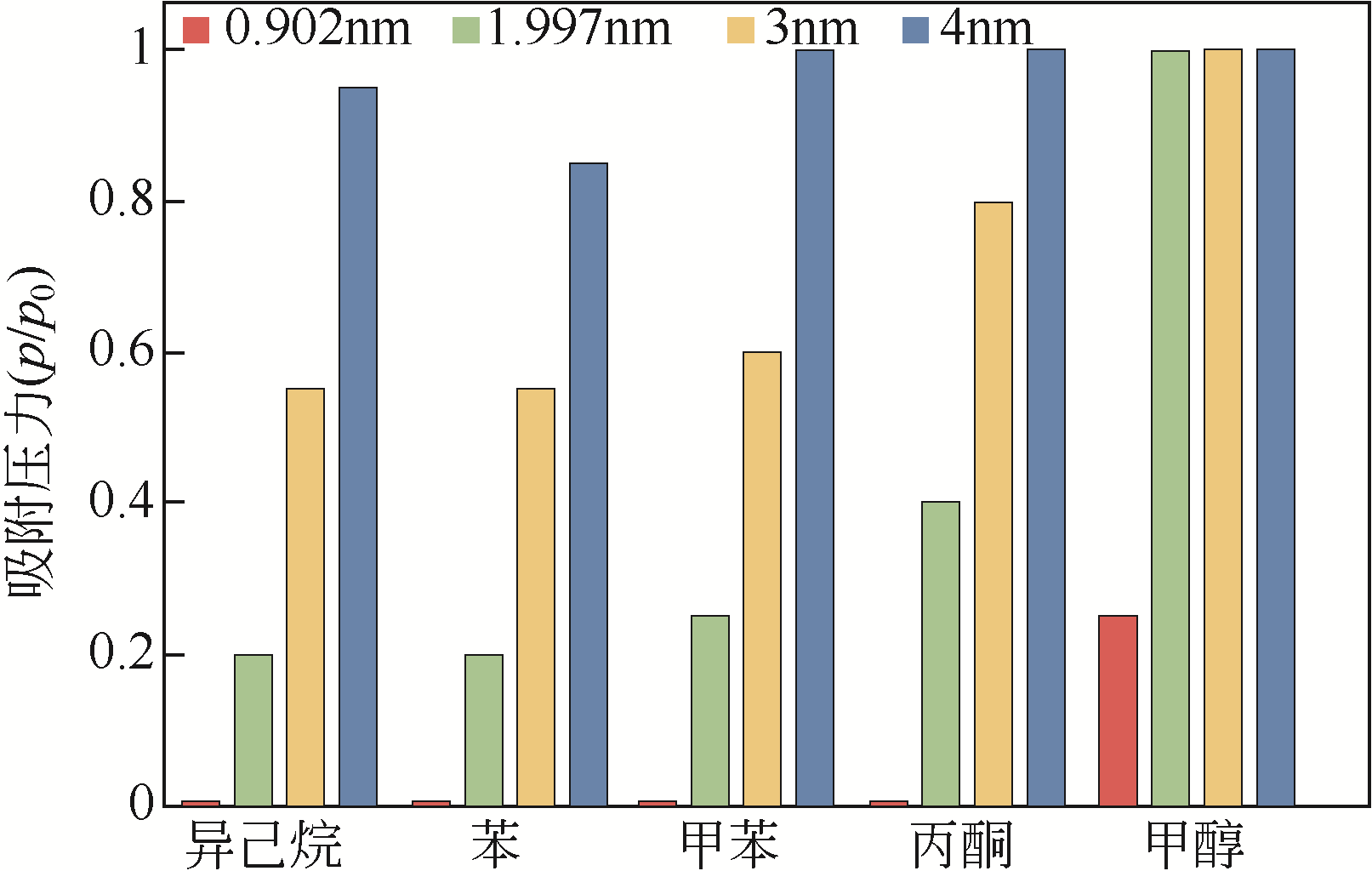| 1 |
DERWENTR G, JENKINM E, SAUNDERSS M, et al. Photochemical ozone formation in north west Europe and its control [J]. Atmospheric Environment, 2003, 37(14): 1983-1991.
|
| 2 |
ZHANGXueyang, GAOBin, CREAMERA E, et al. Adsorption of VOCs onto engineered carbon materials: a review [J]. Journal of Hazardous Materials, 2017, 338: 102-123.
|
| 3 |
LILLO-RÓDENASM A, FLETCHERA J, THOMASK M, et al. Competitive adsorption of a benzene-toluene mixture on activated carbons at low concentration [J]. Carbon, 2006, 44(8): 1455-1463.
|
| 4 |
李立清, 宋剑飞, 孙政, 等. 三种VOCs物性对其在活性炭上吸附行为的影响[J]. 化工学报, 2011, 62(10): 2784-2790.
|
|
LILiqing, SONGJianfei, SUNZheng, et al. Effects of properties of three VOCs on activated carbon adsorption [J]. CIESC Journal, 2011, 62(10): 2784-2790.
|
| 5 |
SCHULLEM, SCHWEITZERM, BÖRGERG. Luftreinhaltung, Partikelabscheidung [J]. Chemie Ingenieur Technik, 1991, 63(11): 1074-1084.
|
| 6 |
SASAKIT, MATSOMUTUA, YAMASHITAY. The effect of the pore size and volume of activated carbon on adsorption efficiency of vapor phase compounds in cigarette smoke [J]. Colloids & Surfaces A: Physicochemical & Engineering Aspects, 2008, 325(3): 166-172.
|
| 7 |
BUCZEKB, ŚWIĄTKOWSKIA, ZIETEKS, et al. Adsorption properties and porous structure within granules of activated carbons with different burn-off [J]. Fuel, 2000, 79(10): 1247-1253.
|
| 8 |
SZCZESNIAKB, CHOMAJ, JARONIECM. Effect of graphene oxide on the adsorption properties of ordered mesoporous carbons toward H2, C6H6, CH4, and CO2 [J]. Microporous & Mesoporous Materials, 2018, 261: 105-110.
|
| 9 |
刘伟, 李立清, 姚小龙, 等. 活性炭孔隙结构在其甲苯吸附中的作用[J]. 环境工程学报, 2012, 6(9): 3210-3218.
|
|
LIUWei, LILiqing, YAOXiaolong, et al. Pore structure effects on activated carbon adsorption behavior for toluene [J]. Chinese Journal of Environmental Engineering, 2012, 6(9): 3210-3218.
|
| 10 |
曹达鹏, 汪文川, 矫庆泽. 层柱状微孔材料吸附存储天然气的Monte Carlo模拟[J]. 化学学报, 2001, 59(2): 297-300.
|
|
CAODapeng, WANGWenchuan, JIAOQingze. Monte Carlo simulation of natural gas adsorption storage in pillared layered material [J]. Acta Chimica Sinica, 2001, 59(2): 297-300.
|
| 11 |
池君杰, 梁晓怿, 余青霓, 等. 分子模拟研究活性炭表面官能团对丙酮吸附的影响[J]. 航天医学与医学工程, 2015, 28(4): 284-287.
|
|
CHIJunjie, LIANGXiaoyi, YUQingni, et al. Molecular simulation study on influence of surface functional groups of activated carbon on acetone adsorption [J]. Space Medicine & Medical Engineering, 2015, 28(4): 284-287.
|
| 12 |
LIANGXiaoyi, CHIJunjie, YANGZhen. The influence of the functional group on activated carbon for acetone adsorption property by molecular simulation study [J]. Microporous & Mesoporous Materials, 2017, 262: 77-88.
|
| 13 |
李勤勤, 张志娟, 李杨, 等. 石油炼化无组织VOCs的排放特征及臭氧生成潜力分析[J]. 中国环境科学, 2016, 36(5): 1323-1331.
|
|
LIQinqin, ZHANGZhijuan, LIYang, et al. Characteristics and ozone formation potential of fugitive volatile organic compounds (VOCs) emitted from petrochemical industry in Pearl River Delta [J]. China Environmental Science, 2016, 36(5): 1323-1331.
|
| 14 |
余益军, 戴玄吏, 王荣俊, 等. 化工园区空气中非甲烷总烃与挥发性有机物的定量关系[J]. 化工环保, 2010, 30(5): 454-457.
|
|
YUYijun, DAIXuanli, WANGRongjun, et al. Quantitative relationship between non methane hydrocarbons and volatile organic compounds in air of a chemical industrial park [J]. Environmental Protection of Chemical Industry, 2010, 30(5): 454-457.
|
| 15 |
LUXiaoqing, JINDongliang, WEIShuxian, et al. Competitive adsorption of a binary CO2-CH4 mixture in nanoporous carbons: effects of edge-functionalization [J]. Nanoscale, 2015, 7(3): 1002.
|
| 16 |
DELLEYB. From molecules to solids with the DMol3 approach [J]. Journal of Chemical Physics, 2000, 113(18): 7756-7764.
|
| 17 |
DELLEYB. Fast calculation of electrostatics in crystals and large molecules [J]. Journal of Physical Chemistry, 1996, 100(15): 6107-6110.
|
| 18 |
PERDEWJ P, BURKEK, ERNZERHOFM. Generalized gradient approximation made simple [J]. Physical Review Letters, 1996, 77(18): 3865-3868.
|
| 19 |
NIEXiaowa, JIANGXiao, WANGHaozhi, et al. Mechanistic understanding of alloy effect and water promotion for Pd-Cu bimetallic catalysts in CO2 hydrogenation to methanol [J]. ACS Catalysis, 2018: 7b04150.
|
| 20 |
LIM D H, NERREIRAA S, WILCOXJ. DFT Studies on the interaction of defective graphene-supported Fe and Al nanoparticles [J]. Journal of Physical Chemistry C, 2011, 115(18): 8961-8970.
|
| 21 |
AOZ M, LIS, JIANGQ. Correlation of the applied electrical field and CO adsorption/desorption behavior on Al-doped graphene [J]. Solid State Communications, 2010, 150(13): 680-683.
|
| 22 |
DAVIESG M, SEATONN A. Development and validation of pore structure models for adsorption in activated carbons [J]. Langmuir, 1999, 15(19): 6263-6276.
|
| 23 |
GEORGAKISM, STAVROPOULOSG, SAKELLAROPOULOSG P. Molecular dynamics study of hydrogen adsorption in carbonaceous microporous materials and the effect of oxygen functional groups [J]. International Journal of Hydrogen Energy, 2007, 32(12): 1999-2004.
|
| 24 |
GEORGEP LS, LOUKASD P, GEORGEC B, et al. Monte Carlo simulation of carbon monoxide, carbon dioxide and methane adsorption on activated carbon [J]. Molecular Physics, 2012, 110(11/12): 1153-1160.
|
| 25 |
SHEVADEA V, JIANGShaoyi, GUBBINSK E. Molecular simulation study of water-methanol mixtures in activated carbon pores [J]. Journal of Chemical Physics, 2000, 113(16): 6933-6942.
|
| 26 |
SUNH. COMPASS: An ab initio force-field optimized for condensed-phase applications overview with details on alkane and benzene compounds [J]. Journal of Physical Chemistry B, 1998, 102(38): 7338-7364.
|
| 27 |
SUNH, RENP, FRIEDJ R. The COMPASS force field: parameterization and validation for phosphazenes [J]. Computational & Theoretical Polymer Science, 1998, 8(1/2): 229-246.
|
| 28 |
刘光启. 化学化工物性数据手册[M]. 北京: 化学工业出版社, 2002.
|
|
LIUGuangqi. Chemical properties data book [M]. Beijing: Chemical Industry Press, 2002.
|
| 29 |
PHADUNGBUTP, DO D D, NICHOLSOND. Undulation theory and analysis of capillary condensation in cylindrical and spherical pores [J]. The Journal of Physical Chemistry C, 2015: 150820094346009.
|
| 30 |
RAFATIA A, HASHEMIANZADEHS M, MAHDAVIFARZ, et al. Canonical Monte Carlo simulation of adsorption of O2 and N2 mixture on single walled carbon nanotube at different temperatures and pressures [J]. Journal of Computational Chemistry, 2010, 31(7): 1443-1449.
|
 ),付强,刘冰,汪亚燕,江南,邢瑞,张东辉(
),付强,刘冰,汪亚燕,江南,邢瑞,张东辉( ),唐忠利
),唐忠利
 ),Qiang FU,Bing LIU,Yayan WANG,Nan JIANG,Rui XING,Donghui ZHANG(
),Qiang FU,Bing LIU,Yayan WANG,Nan JIANG,Rui XING,Donghui ZHANG( ),Zhongli TANG
),Zhongli TANG




